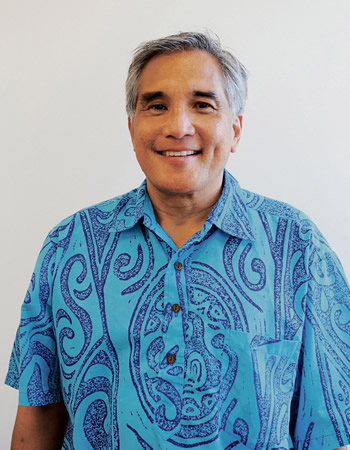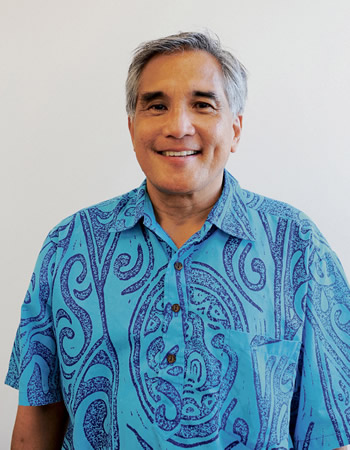Researching Nuclear Exposure
Dr. Neal Palafox
Researcher at the John A. Burns School of Medicine
Where did you receive your schooling/training?
I was born in Hawaii. I went to University Lab School and then Whitman College in the state of Washington. I came back to Hawaii and went to the John A. Burns School of Medicine (JABSOM), and then did my internship and residency in family medicine at UCLA Hospital and Clinics. I had a National Health Service Corps scholarship during medical school, so I owed two years of medical service in under-served areas such as federal prison, Native American reservations or at community health centers. Molokai was a site, as were all departments of health in the U.S. Associated Pacific (Guam, Saipan, Federated States of Micronesia, American Samoa, Marshall Islands). I chose to go to the Marshall Islands and ended up working there almost 10 years. After that, I completed a master’s degree in public health at Johns Hopkins and then came on staff at the Department of Family Medicine and Community Health at JABSOM.
I started as the research director and then was the department chairman for almost 13 years. I stepped away from chair this year, but I’m still with the department, doing many things. Our department has a clinic in Mililani where we train family medicine interns, residents and medical students. Wahiawa General Hospital sponsors the residency for inpatient medicine and outpatient medical care. Kapiolani is where the resident physicians do obstetric care. Queen’s Medical Center and Wahiawa General Hospital are where the residents learn critical care. The resident physicians learn all components of family medicine and engage in research projects as well.
Has most of your research been on Micronesia?
Growing up in Hawaii, I knew little about Micronesia, but when I was at medical school I would always hear about the medical dilemmas of the Pacific. After I finished medical school, I made a beeline for the U.S. territories in Micronesia.
The Micronesians in general and the Marshallese in particular are a generous, wonderful people. As far as medical health, it was like a Third World country. When I saw tuberculosis, cases of severe ciguatera, Hansen’s disease, cholera, epidemic syphilis, severe malnutrition – many illnesses we do not see in Hawaii – I became interested in improvement of public health. During my time there, I was asked to set up one of the first expanded programs for peoples of four atolls affected by U.S. nuclear testing. I became very interested in the effects of radiation contamination. There was little systematic care for all of the people who were affected by nuclear testing.
After nearly 10 years there, I went to Johns Hopkins for formal training about research and received a master’s in public health. In the interim I kept doing projects with the Marshallese, some on vitamin A deficiency, some on syphilis outbreaks, and also on the problems they were having because of increased tobacco sales. The Marshall Islands was the first place outside of the U.S. to take the American tobacco companies to court.
Because I had worked so much with cancer and nuclear testing, in 1997 other Micronesian countries, noting numerous cancer cases, were interested in quantifying and managing their cancer burden. From ’97 till today I’ve been looking for funds and grants, and since that time, working with many Pacific partnerships, have received more than $25 million in federal grants that are targeted at comprehensive cancer preventions and control in the U.S. Pacific.
I didn’t go to the Marshalls looking for cancer, but I found a problem that was deeply ingrained in U.S. history and nuclear testing history. From 1946 to ’58 the U.S. tested its nuclear weapons in the Marshall Islands, even before the Marshall Islands was an official U.S. territory. They did 67 nuclear tests during this period, which were equivalent in explosive power to 7,200 Hiroshima bombs. The testing was performed predominantly above ground. Eighty-five percent of all nuclear weapons testing by the U.S. was done in the Marshall Islands. For the U.S., the ideal geographic sites for testing were inhabited by Marshallese, so they asked the people to move during the testing. Fifty years later, parts of these sites are still contaminated, so the people are afraid to move back.
In 1954, the U.S., in nuclear arms race with the USSR, tested a hydrogen bomb that alone was equal in megatonage to 1,000 Hiroshima bombs. We were flexing to show “mine is bigger than yours.” Collateral damage from the Cold War fell on the Marshallese, and the effects continue today. From 1998 to 2008 I became further involved as the director for a U.S. Department of Energy-funded program to provide care for the peoples of the Marshall Islands affected by this hydrogen bomb test called Bravo.
Did you help with the Fukushima disaster?
I got tied to it because of my work with the nuclear-affected people of the Marshall Islands and because of the developing relationship between the Department of Family Medicine and Community Health at JABSOM and the Family Medicine Departments at Fukushima Medical University. In the interest of developing its family medicine curriculum, the head and professor of that program, Dr. Ryuki Kessai, with faculty members and resident physicians, came to Hawaii in 2008 and ’09 to learn about the curriculum and teaching processes of family medicine in the U.S. and Hawaii.
We spoke about my involvement as the director of a U.S. Department of Energy-funded program to provide health care for the people of the Marshall Islands affected by nuclear testing, and how the department resident physicians and faculty were integrally involved with that program.
The day after the tidal wave, I got an email from Dr. Kessai. He wanted to understand the nuclear effects of radiation. People were getting contaminated; there were few resources. They wanted to know the public health effects. What should and shouldn’t we do? I got our interns and residents together to help. I had lots of information, but it was in English. We had two resident physicians who trained in Japan and who spoke and wrote fluent Japanese. I asked them to translate it, and others residents and faculty to put together other current information on the effects of radiation exposure. One of our resident physicians developed a Fukushima website.
Any final thoughts?
My interest is the impact on the Micronesians who are here in Hawaii. Public sentiment about them is negative. When they come to Hawaii, they’re portrayed as dirty, that they utilize a lot of health and education resources. Many don’t speak English well, have difficulty navigating the health and social system, and have a heavy burden of illness, such as diabetes and cancer. Some of their burden of illness can be attributed to the effects of the U.S. nuclear testing that was not adequately addressed.







